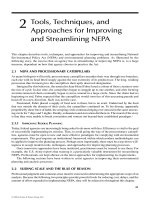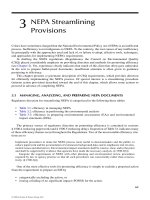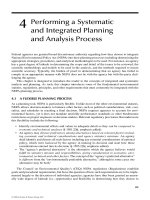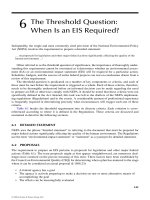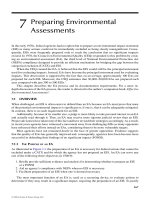spatial databases technologies techniques and trends
Bạn đang xem bản rút gọn của tài liệu. Xem và tải ngay bản đầy đủ của tài liệu tại đây (5.79 MB, 359 trang )
i
Hershey • London • Melbourne • Singapore
Spatial Databases:
Technologies, Techniques
and Trends
Yannis Manolopoulos
Aristotle University of Thessaloniki, Greece
Apostolos N. Papadopoulos
Aristotle University of Thessaloniki, Greece
Michael Gr. Vassilakopoulos
Technological Educational Institute of Thessaloniki, Greece
IDEA GROUP PUBLISHING
ii
Acquisitions Editor: Mehdi Khosrow-Pour
Senior Managing Editor: Jan Travers
Managing Editor: Amanda Appicello
Development Editor: Michele Rossi
Copy Editor: Julie LeBlanc
Typesetter: Rachel Shepherd
Cover Design: Lisa Tosheff
Printed at: Integrated Book Technology
Published in the United States of America by
Idea Group Publishing (an imprint of Idea Group Inc.)
701 E. Chocolate Avenue, Suite 200
Hershey PA 17033-1240
Tel: 717-533-8845
Fax: 717-533-8661
E-mail:
Web site:
and in the United Kingdom by
IRM Press (an imprint of Idea Group Inc.)
3 Henrietta Street
Covent Garden
London WC2E 8LU
Tel: 44 20 7240 0856
Fax: 44 20 7379 3313
Web site:
Copyright © 2005 by Idea Group Inc. All rights reserved. No part of this book may be repro-
duced in any form or by any means, electronic or mechanical, including photocopying, without
written permission from the publisher.
Library of Congress Cataloging-in-Publication Data
Spatial databases : technologies, techniques and trends / Yannis Manolopoulos, Apostolos N.
Papadopoulos and Michael Gr. Vassilakopoulos, Editors.
p. cm.
Includes bibliographical references and index.
ISBN 1-59140-387-1 (h/c) ISBN 1-59140-388-X (s/c) ISBN 1-59140-389-8 (ebook)
1. Database management. 2. Geographic information systems. I. Manolopoulos, Yannis, 1957- II.
Papadopoulos, Apostolos N. III. Vassilakopoulos, Michael Gr.
QA76.9.D3S683 2004
005.74 dc22 2004021989
British Cataloguing in Publication Data
A Cataloguing in Publication record for this book is available from the British Library.
All work contributed to this book is new, previously-unpublished material. The views expressed in
this book are those of the authors, but not necessarily of the publisher.
iii
Preface vii
Section I: Modelling and Systems
Chapter I
Survey on Spatial Data Modelling Approaches 1
Jose R. Rios Viqueira, University of A Coruña, Spain
Nikos A. Lorentzos, Agricultural University of Athens, Greece
Nieves R. Brisaboa, University of A Coruña, Spain
Chapter II
Integrating Web Data and Geographic Knowledge into Spatial
Databases 23
Alberto H.F. Laender, UFMG – Federal University of Minas
Gerais, Brazil
Karla A.V. Borges, UFMG – Federal University of Minas
Gerais, Brazil & PRODABEL, Brazil
Joyce C.P. Carvalho, UFMG – Federal University of Minas
Gerais, Brazil
Claudia B. Medeiros, UNICAMP – University of Campinas, Brazil
Altigran S. da Silva, Federal University of Amazonas, Brazil
Clodoveu A. Davis Jr., PRODABEL and Catholic University of
Minas Gerais, Brazil
Spatial Databases:
Technologies,
Techniques and Trends
Table of Contents
iv
Section II: Indexing Techniques
Chapter III
Object-Relational Spatial Indexing 49
Hans-Peter Kriegel, University of Munich, Germany
Martin Pfeifle, University of Munich, Germany
Marco Pötke, sd&m AG, Germany
Thomas Seidl, RWTH Aachen University, Germany
Jost Enderle, RWTH Aachen University, Germany
Chapter IV
Quadtree-Based Image Representation and Retrieval 81
Maude Manouvrier, LAMSADE – Université Paris-Dauphine,
France
Marta Rukoz, CCPD – Universidad Central de Venezuela,
Venezuela
Geneviève Jomier, LAMSADE – Université Paris-Dauphine,
France
Chapter V
Indexing Multi-Dimensional Trajectories for Similarity Queries 107
Michail Vlachos, IBM T.J. Watson Research Center, USA
Marios Hadjieleftheriou, University of California-Riverside, USA
Eamonn Keogh, University of California-Riverside, USA
Dimitrios Gunopulos, University of California-Riverside, USA
Section III: Query Processing and Optimization
Chapter VI
Approximate Computation of Distance-Based Queries 130
Antonio Corral, University of Almeria, Spain
Michael Vassilakopoulos, Technological Educational Institute of
Thessaloniki, Greece
Chapter VII
Spatial Joins: Algorithms, Cost Models and Optimization
Techniques 155
Nikos Mamoulis, University of Hong Kong, Hong Kong
Yannis Theodoridis, University of Piraeus, Greece
Dimitris Papadias, Hong Kong University of Science and
Technology, Hong Kong
v
Section IV: Moving Objects
Chapter VIII
Applications of Moving Objects Databases 186
Ouri Wolfson, University of Illinois, USA
Eduardo Mena, University of Zaragoza, Spain
Chapter IX
Simple and Incremental Nearest-Neighbor Search in
Spatio-Temporal Databases 204
Katerina Raptopoulou, Aristotle University of Thessaloniki,
Greece
Apostolos N. Papadopoulos, Aristotle University of Thessaloniki,
Greece
Yannis Manolopoulos, Aristotle University of Thessaloniki,
Greece
Chapter X
Management of Large Moving Objects Databases: Indexing,
Benchmarking and Uncertainty in Movement Representation 225
Talel Abdessalem, Ecole Nationale Supérieure des
Télécommunications, France
Cédric du Mouza, Conservatoire National des Arts et Métiers,
France
José Moreira, Universidade de Aveiro, Portugal
Philippe Rigaux, University of Paris Sud, France
Section V: Data Mining
Chapter XI
Spatio-Temporal Prediction Using Data Mining Tools 251
Margaret H. Dunham, Southern Methodist University, Texas,
USA
Nathaniel Ayewah, Southern Methodist University, Texas, USA
Zhigang Li, Southern Methodist University, Texas, USA
Kathryn Bean, University of Texas at Dallas, USA
Jie Huang, University of Texas Southwestern Medical Center,
USA
Chapter XII
Mining in Spatio-Temporal Databases 272
Junmei Wang, National University of Singapore, Singapore
Wynne Hsu, National University of Singapore, Singapore
Mong Li Lee, National University of Singapore, Singapore
vi
Chapter XIII
Similarity Learning in GIS: An Overview of Definitions,
Prerequisites and Challenges 294
Giorgos Mountrakis, University of Maine, USA
Peggy Agouris, University of Maine, USA
Anthony Stefanidis, University of Maine, USA
About the Authors 322
Index 336
vii
Preface
Spatial database systems has been an active area of research over the past 20
years. A large number of research efforts have appeared in literature aimed at
effective modelling of spatial data and efficient processing of spatial queries.
This book investigates several aspects of a spatial database system, and in-
cludes recent research efforts in this field. More specifically, some of the top-
ics covered are: spatial data modelling; indexing of spatial and spatio-temporal
objects; data mining and knowledge discovery in spatial and spatio-temporal
databases; management issues; and query processing for moving objects. There-
fore, the reader will be able to get in touch with several important issues that
the research community is dealing with. Moreover, each chapter is self-con-
tained, and it is easy for the non-specialist to grasp the main issues.
The authors of the book’s chapters are well-known researchers in spatial data-
bases, and have offered significant contributions to spatial database literature.
The chapters of this book provide an in-depth study of current technologies,
techniques and trends in spatial and spatio-temporal database systems research.
Each chapter has been carefully prepared by the contributing authors, in order
to conform with the book’s requirements.
Intended Audience
This book can be used by students, researchers and professionals interested in
the state-of-the-art in spatial and spatio-temporal database systems. More spe-
cifically, the book will be a valuable companion for postgraduate students studying
spatial database issues, and for instructors who can use the book as a refer-
viii
ence for advanced topics in spatial databases. Researchers in several related
areas will find this book useful, since it covers many important research direc-
tions.
Prerequisites
Each chapter of the book is self-contained, to help the reader focus on the
corresponding issue. Moreover, the division of the chapters into sections is very
convenient for those focusing on different research issues. However, at least a
basic knowledge of indexing, query processing and optimization in traditional
database systems will be very helpful in more easily understanding the issues
covered by each chapter.
Overview of Spatial Database Issues
Spatial database management systems aim at supporting queries that involve
the space characteristics of the underlying data. For example, a spatial data-
base may contain polygons that represent building footprints from a satellite
image, or the representation of lakes, rivers and other natural objects. It is
important to be able to query the database by using predicates related to the
spatial and geometric characteristics of the objects.
To handle such queries, a spatial database system is enhanced by special tools.
These tools include new data types, sophisticated indexing mechanisms and
algorithms for efficient query processing that differ from their counterparts in a
conservative alphanumeric database. The contribution of the research commu-
nity over the past 20 years includes a plethora of significant research results
toward this goal.
An important research direction in spatial databases is the representation and
support of the time dimension. In many cases, objects change their locations
and shape. In order to query past or future characteristics, effective represen-
tation and query processing techniques are required. A spatial database en-
hanced by tools to incorporate time information is called a spatio-temporal
database system. The applications of spatio-temporal databases are very sig-
nificant, since such systems can be used in location-aware services, traffic
monitoring, logistics, analysis and prediction. Indexing techniques for pure spa-
tial datasets cannot be directly applied in a spatio-temporal dataset, because
time must be supported efficiently.
ix
Apart from supporting queries involving space and time characteristics of the
underlying dataset, similarity of object movement has also been studied in lit-
erature. The target is to determine similar object movement by considering the
trajectories of the moving objects. The similarity between two object trajecto-
ries is a very important tool that can help reveal similar behavior and define
clusters of objects with similar motion patterns.
The research area of data mining studies efficient methods for extracting knowl-
edge from a set of objects, such as association rules, clustering and prediction.
The application of data mining techniques in spatial data yielded the interesting
research field of spatial data mining. Recently, spatio-temporal data mining has
emerged, to take into consideration the time dimension in the knowledge ex-
traction process.
Several of the aforementioned research issues in spatial databases are covered
by this book.
Book Organization
The book is composed of 13 chapters, organized in five major sections accord-
ing to the research issue covered:
I) Modelling and Systems
II) Indexing Techniques
III) Query Processing and Optimization
IV) Moving Objects
V) Data Mining
In the sequel we describe briefly the topics covered in each section, giving the
major issues studied in each chapter.
Section I focuses on modelling and system issues in spatial databases.
Chapter I identifies properties that a spatial data model, dedicated to support
spatial data for cartography, topography, cadastral and relevant applications,
should satisfy. The properties concern the data types, data structures and spa-
tial operations of the model. A survey of various approaches investigates mainly
the satisfaction of these properties. An evaluation of each approach against
these properties also is included.
In Chapter II the authors study the impact of the Web to Geographic Informa-
tion Systems (GIS). With the phenomenal growth of the Web, rich data sources
x
on many subjects have become available online. Some of these sources store
daily facts that often involve textual geographic descriptions. These descrip-
tions can be perceived as indirectly georeferenced data – e.g., addresses, tele-
phone numbers, zip codes and place names. This chapter’s focus is on using
the Web as an important source of urban geographic information. Additionally,
proposals to enhance urban GIS using indirectly georeferenced data extracted
from the Web are included. An environment is described that allows the extrac-
tion of geospatial data from Web pages, converts them to XML format and
uploads the converted data into spatial databases for later use in urban GIS.
The effectiveness of this approach is demonstrated by a real urban GIS appli-
cation that uses street addresses as the basis for integrating data from different
Web sources, combining the data with high-resolution imagery.
Section II contains three chapters that study efficient methods for indexing
spatial and spatio-temporal datasets.
Chapter III studies object-relational indexing as an efficient solution to enable
spatial indexing in a database system. Although available extensible indexing
frameworks provide a gateway for seamless integration of spatial access methods
into the standard process of query optimization and execution, they do not fa-
cilitate the actual implementation of the spatial access method. An internal en-
hancement of the database kernel is usually not an option for database develop-
ers. The embedding of a custom block-oriented index structure into concurrency
control, recovery services and buffer management would cause extensive imple-
mentation efforts and maintenance cost, at the risk of weakening the reliability
of the entire system. The authors present the paradigm of object-relational
spatial access methods that perfectly fits with the common relational data model
and is highly compatible with the extensible indexing frameworks of existing
object-relational database systems, allowing the user to define application-spe-
cific access methods.
Chapter IV contains a survey of quadtree uses in the image domain, from im-
age representation to image storage and content-based retrieval. A quadtree is
a spatial data structure built by a recursive decomposition of space into quad-
rants. Applied to images, it allows representing image content, compacting or
compressing image information, and querying images. For 13 years, numerous
image-based approaches have used this structure. In this chapter, the authors
underline the contribution of quadtree in image applications.
With the abundance of low-cost storage devices, a plethora of applications that
store and manage very large multi-dimensional trajectory (or time-series)
datasets have emerged recently. Examples include traffic supervision systems,
video surveillance applications, meteorology and more. Thus, it is becoming
essential to provide a robust trajectory indexing framework designed especially
for performing similarity queries in such applications. In this regard, Chapter V
presents an indexing scheme that can support a wide variety of (user-
xi
customizable) distance measures, while at the same time guaranteeing retrieval
of similar trajectories with accuracy and efficiency.
Section III studies approximate computation of distanced-based queries and
algorithms, cost models and optimization for spatial joins.
Chapter VI studies the problem of approximate query processing for distance-
based queries. In spatial database applications, the similarity or dissimilarity of
complex objects is examined by performing distance-based queries (DBQs) on
data of high dimensionality (a generalization of spatial data). The R-tree and its
variations are commonly cited as multidimensional access methods that can be
used for answering such queries. Although the related algorithms work well for
low-dimensional data spaces, their performance degrades as the number of
dimensions increases (dimensionality curse). To obtain acceptable response time
in high-dimensional data spaces, algorithms that obtain approximate solutions
can be used. This chapter reviews the most important approximation techniques
for reporting sufficiently good results quickly. The authors focus on the design
choices of efficient approximate DBQ algorithms that minimize response time
and the number of I/O operations over tree-like structures. The chapter con-
cludes with possible future research trends in the approximate computation of
DBQs.
Chapter VII describes algorithms, cost models and optimization techniques for
spatial joins. Joins are among the most common queries in Spatial Database
Management Systems. Due to their importance and high processing cost, a
number of algorithms have been proposed covering all possible cases of in-
dexed and non-indexed inputs. The authors first describe some popular meth-
ods for processing binary spatial joins, and provide models for selectivity and
cost estimation. Then, they study the evaluation of multiway spatial joins by
integrating binary algorithms and synchronous tree traversal. Going one step
further, the authors show how analytical models can be used to combine the
various join operators in optimal evaluation plans.
Section IV deals with moving objects databases, and studies efficient algo-
rithms, management issues and applications.
Chapter VIII presents the applications of Moving Objects Databases (MODs)
and their functionality. Miniaturization of computing devices and advances in
wireless communication and sensor technology are some of the forces propa-
gating computing from the stationary desktop to the mobile outdoors. Some
important classes of new applications that will be enabled by this revolutionary
development include location-based services, tourist services, mobile electronic
commerce and digital battlefield. Some existing application classes that will
benefit from the development include transportation and air traffic control,
weather forecasting, emergency response, mobile resource management and
mobile workforce. Location management, i.e., the management of transient
location information, is an enabling technology for all these applications. Loca-
xii
tion management also is a fundamental component of other technologies, such
as fly-through visualization, context awareness, augmented reality, cellular com-
munication and dynamic resource discovery. MODs store and manage the lo-
cation as well as other dynamic information about moving objects.
Chapter IX presents several important aspects toward simple and incremental
nearestneighbor searches for spatio-temporal databases. More specifically, the
authors describe the algorithms that already have been proposed for simple and
incremental nearest-neighbor queries, and present a new algorithm. Finally, the
chapter studies the problem of keeping a query consistent in the presence of
insertions, deletions and updates of moving objects. Applications of MODs have
rapidly increased, because mobile computing and wireless technologies nowa-
days are ubiquitous.
Chapter X deals with important issues pertaining to the management of moving
objects datasets in databases. The design of representative benchmarks is closely
related to the formal characterization of the properties (i.e., distribution, speed,
nature of movement) of these datasets; uncertainty is another important aspect
that conditions the accuracy of the representation and therefore the confidence
in query results. Finally, efficient index structures, along with their compatibil-
ity with existing software, is a crucial requirement for spatio-temporal data-
bases, as it is for any other kind of data.
Section V, the final section of the book, contains two chapters that study the
application of data mining techniques to spatio-temporal databases.
Recent interest in spatio-temporal applications has been fueled by the need to
discover and predict complex patterns that occur when we observe the behav-
ior of objects in the three-dimensional space of time and spatial coordinates.
Althoughcomplex and intrinsic relationships among the spatio-temporal data limit
the usefulness of conventional data mining techniques to discover the patterns
in the spatio-temporal databases, they also lead to opportunities for mining new
classes of patterns. Chapter XI provides a survey of the work done for mining
patterns in spatial databases and temporal databases, and the preliminary work
for mining patterns in spatio-temporal databases. The authors highlight the unique
challenges of mining interesting patterns in spatio-temporal databases. Two
special types of spatio-temporal patterns are described: location-sensitive se-
quence patterns and geographical features for location-based service patterns.
The spatio-temporal prediction problem requires that one or more future values
be predicted for time series input data obtained from sensors at multiple physi-
cal locations. Examples of this type of problem include weather prediction,
flood prediction, network traffic flow, etc. Chapter XII provides an overview of
this problem, highlighting the principles and issues that come into play in spatio-
temporal prediction problems. The authors describe recent work in the area of
flood prediction to illustrate the use of sophisticated data mining techniques that
xiii
have been examined as possible solutions. The authors argue the need for fur-
ther data mining research to attack this difficult problem.
In Chapter XIII, the authors review similarity learning in spatial databases.
Traditional exact-match queries do not conform to the exploratory nature of
GIS datasets. Non-adaptable query methods fail to capture the highly diverse
needs, expertise and understanding of users querying for spatial datasets. Simi-
larity-learning algorithms provide support for user preference and therefore
should be a vital part in the communication process of geospatial information.
More specifically, the authors address machine learning as applied in the opti-
mization of query similarity. Appropriate definitions of similarity are reviewed.
Moreover, the authors position similarity learning within data mining and ma-
chine-learning tasks. Furthermore, prerequisites for similarity-learning techniques
based on the unique characteristics of the GIS domain are discussed.
How to Read This Book
The organization of the book has been carefully selected to help the reader.
However, it is not mandatory to study the topics in their order of appearance. If
the reader wishes to perform an in-depth study of a particular subject then he/
she could focus on the corresponding section.
What Makes This Book Different
The reader of this book will get in touch with significant research directions in
the area of spatial databases. The broad field of topics covered by important
researchers is an important benefit. In addition to pure spatial concepts, spatio-
temporal issues also are covered, allowing the reader to make his/her compari-
sons with respect to the similarities and differences of the two domains (i.e.,
spatial and spatio-temporal databases). Each chapter covers the corresponding
topic to a sufficient degree, giving the reader necessary background knowledge
for further reading.
The book covers important research issues in the field of spatial database sys-
tems. Since each book chapter is self-contained, it is not difficult for the non-
expert to understand the topics covered. Although the book is not a textbook, it
can be used in a graduate or a postgraduate course for advanced database
issues.
xiv
A Closing Remark
The authors have made significant efforts to provide high-quality chapters, de-
spite space restrictions. These authors are well-known researchers in the area
of spatial and spatio-temporal databases, and they have offered significant con-
tributions to the literature. We hope that the reader will gain the most out of this
effort.
Yannis Manolopoulos, PhD
Apostolos N. Papadopoulos, PhD
Michael Vassilakopoulos, PhD
Thessaloniki, Greece
2004
xv
Acknowledgments
The editors are grateful to everyone who helped in the preparation of
this book. First, we would like to thank the chapter authors for their
excellent contributions and their collaboration during the editing pro-
cess. We also would like to thank the reviewers, whose comments
and suggestions were valuable in improving the quality and presenta-
tion of the chapters. Moreover, we are grateful to Michele Rossi
from Idea Group Publishing for her help in completing this project.
Finally, we would like to thank all our colleagues for their comments
regarding the issues covered in this book.
Yannis Manolopoulos, PhD
Michael Vassilakopoulos, PhD
Apostolos N. Papadopoulos, PhD
Thessaloniki, Greece
May 2004
Section I
Modelling and Systems
Survey on Spatial Data Modelling Approaches 1
Copyright © 2005, Idea Group Inc. Copying or distributing in print or electronic forms without written
permission of Idea Group Inc. is prohibited.
Chapter I
Survey on
Spatial Data
Modelling Approaches
Jose R. Rios Viqueira, University of A Coruña, Spain
Nikos A. Lorentzos, Agricultural University of Athens, Greece
Nieves R. Brisaboa, University of A Coruña, Spain
Abstract
The chapter identifies properties that a spatial data model, dedicated to
support spatial data for cartography, topography, cadastral and relevant
applications, should satisfy. The properties concern the data types, data
structures and spatial operations of the model. A survey of various
approaches investigates mainly the satisfaction of these properties. An
evaluation of each approach against these properties also is included.
2 Viqueira, Lorentzos & Brisaboa
Copyright © 2005, Idea Group Inc. Copying or distributing in print or electronic forms without written
permission of Idea Group Inc. is prohibited.
Introduction
A lot of research has been undertaken in recent years for the management of
spatial data. Initial approaches in the area of GIS exhausted their efforts in the
precise geometric representation of spatial data and in the implementation of
operations between spatial objects. Subsequently, only primitive effort was made
on the association of spatial data with conventional data. As a consequence, the
management of geographic data had to be split into two distinct types of
processing, one for the spatial data and another for the attributes of conventional
data and their association with spatial data. Effort to define a formal and
expressive language for the easy formulation of queries was almost missing and,
therefore, too much programming was required. Finally, even the processing of
spatial data lacked an underlying formalism. On the other hand, efficient
processing of conventional data can only be achieved from within a Database
Management System (DBMS). Besides, due to its complexity, the management
of spatial data is not possible from within a conventional DBMS.
Because of this, a new research effort was undertaken in the area of spatial
databases. Such effort covered various sectors, such as the design of efficient
physical data structures and access methods, the investigation of query process-
ing and optimization techniques, visual interfaces and so forth. All these
approaches inevitably addressed spatial data modelling issues in an indirect
way, in that spatial data modelling was not their primary objective. However, a
direct way can also be identified, in that research has also been undertaken
dedicated solely to the definition of data models.
This chapter surveys and evaluates spatial data modelling approaches in either
of these types. Wherever applicable, the restriction of spatio-temporal models to
the management of spatial data is also reviewed. In particular, properties
concerning the data types considered, the data structures used and the opera-
tions supported by a data model for the management of cartography, topography,
cadastral and relevant applications, are identified in the background section. A
relevant review and evaluation of spatial data modelling approaches, GIS-
centric and DBMS-centric, follow in the next two sections. Future trends are
discussed in the fifth section, and conclusions are drawn in the last section.
Background
Traditional cartography, topography, cadastral and relevant applications require
the processing of data that can geometrically be represented on a 2-d plane as
Survey on Spatial Data Modelling Approaches 3
Copyright © 2005, Idea Group Inc. Copying or distributing in print or electronic forms without written
permission of Idea Group Inc. is prohibited.
a point, line or surface. For the objectives of this chapter, every such piece of
data, and any set of them as well, is termed spatial data or (spatial) object. This
data is distinguished from conventional data, such as a name (for example, of
a city, river, lake), a number (population of a city, supply of a river, depth of a
lake), a date, and so forth. Data modelling requires specifying at minimum data
types, data structures and operations.
The same is true for spatial data. However, spatial data have much individuality.
To provide a few examples, consider spatial data of the three distinct common
types: point, line and surface. Consider also Figure 1, which depicts some
commonly used operations on spatial data (termed in this chapter spatial
operations). It is then noted that the result of an operation between two spatial
objects does not necessarily yield only one such object, but it may consist of two
(Figure 1(a) case (ii), Figure 1(b) cases (ii) and (iv), Figure 1(c) case (ii)), more
than two (Figure 1(c) case (iv)) and perhaps none (Figure 1(c) case (iii)). Also,
the data type of the result objects may not necessarily match that of the input
object(s) (Figure 1(a) case (iv) and Figure 1(c) case (iv)). Finally, the result of
an operation may also contain objects that are combinations of surfaces with
lines termed, for the objectives of this chapter, hybrid surfaces (Figure 1(a)
case (iv), 1(c) case (iv)).
To face this individuality and at the same time define closed spatial operations,
many distinct spatial data modelling approaches have been proposed. Many of
them have the following characteristics: (i) They adopt set-based data types,
such as set of points, set of surfaces, and so forth. (ii) They use either complex
data structures to record spatial data or two types of such structures, one to
record spatial and another to record conventional data. (iii) They define
operations that apply to spatial data of one specific type; for example, Overlay
only between surfaces. Other operations discard part of the result; for example,
the point and line parts produced by the spatial intersection of two surfaces
(Figure 1(c) case (iv)). However, a data model should be simple, and enable a
most accurate mapping of the real world (Tsichritzis & Lochovsky, 1982). As
opposed to the above observations, it is estimated that a spatial model should
satisfy the following properties:
• Spatial Data Types: It should support the point, line and surface types,
since in daily practice people are familiar with the use of these objects.
• Data Structures: They should be simple. As opposed to the First Normal
Form (1NF) relational model, for example, it is noticed that a nested model,
though more powerful, is more difficult to both implement and use.
Similarly, it is penalizing for the user to process two distinct data structures.
• Spatial Operations: They should apply to structures containing any type
of spatial data. Two examples: It is practical to (i) apply Overlay to lines,
4 Viqueira, Lorentzos & Brisaboa
Copyright © 2005, Idea Group Inc. Copying or distributing in print or electronic forms without written
permission of Idea Group Inc. is prohibited.
Figure 1. Illustration of operations on spatial data
Survey on Spatial Data Modelling Approaches 5
Copyright © 2005, Idea Group Inc. Copying or distributing in print or electronic forms without written
permission of Idea Group Inc. is prohibited.
and (ii) apply an operation to two spatial objects of a different type, such
as to compute the intersection of a surface with a line. Finally, pieces of data
should not be discarded from the result of an operation.
Relevant to the operations that should be supported, it is estimated that for
topographic, cartographic, cadastral and relevant applications, with which this
chapter is mainly concerned, a spatial data model should support at least those
in Figure 1. Indeed, many researchers have proposed the operations in Figure
1(a)-(d), which also match actual user requirements. Fewer researchers have
proposed the remaining operations, but the authors estimate that they have
general practical interest. Some explanations on these operations are the
following: As opposed to Spatial Union, Fusion (Figure 1(a)) returns the results
indicated only in the case that the pieces of conventional data, with which spatial
data are associated, are identical. The subtraction of a point or line from a
surface should return the surface itself (Figure 1(b) case (iii)). Indeed, it does not
make sense to consider surfaces with missing points or lines. A similar remark
applies to the subtraction of points from lines. Tables are used in the four
Overlay operations to show the association of spatial with conventional data.
Finally, the illustration of Spatial Buffer (Figure 1(e)) considers a distance of
d = 1.
A brief review of various approaches for the management of spatial data, which
follows, focuses mainly on the spatial data types considered, data structures used
and support of the spatial operations shown in Figure 1. Wherever estimated to
be necessary, more operations of a data model are presented. An evaluation of
each approach also is given in Figure 2. The evaluation is based on the following
criteria: (i) Support of point, line and surface types. (ii) Use of simple data
structures, as opposed to the use of complex or more than one type of structure.
(iii) Application of an operation to all types of spatial data, without discarding any
part of the result. In Figure 2, a ‘Y’, ‘N’ or ‘P’ denotes, respectively, that a
property is satisfied, not satisfied or satisfied partially. ‘N/A’ denotes that the
property does not apply to the approach under consideration. Finally, ‘?’ denotes
that satisfaction of the property is not clear from the literature. Note that the
evaluation was a hard task, due to the lack of formalism. To ease discussion, the
approaches have been divided into two major classes, GIS-centric and DBMS-
centric (IBM, 1998), and are reviewed separately in the next two sections.
6 Viqueira, Lorentzos & Brisaboa
Copyright © 2005, Idea Group Inc. Copying or distributing in print or electronic forms without written
permission of Idea Group Inc. is prohibited.
Figure 2. Evaluation of spatial approaches
Tomlin 1990
Erwig & Schneider 1997
d’Onofrio & Pourabbas 2001
Hadzilacos & Tryfona 1996
ESRI 2003
Intergraph Corp. 2002
Bentley Systems 2001
GRASS 2002.
Kemp & Kowalczyk 1994
MapInfo Corp. 2002
Güting & Schneider 1995
Güting et al. 2000
Worboys 1994
Larue et al. 1993
Egenhofer 1994
Roussopoulos et al. 1988
Scholl & Voisard 1992
Böhlen et al. 1998
Chen & Zaniolo 2000
Gargano et al. 1991
Svensson & Huang 1991
Güting 1988
Chan & Zhu 1996
Grumbach et al. 1998
Kuper et al. 1998
van Roessel 1994
Scholl & Voisard 1989
Yeh & de Cambray 1995
ISO/IEC 2002
Oracle Corp. 2000
IBM 2001b
PostgreSQL 2001
Cheng & Gadia 1994
OpenGIS 1999
IBM 2001a
Vijlbrief& vanOosterom 1992
Park et al. 1998
Voigtmann 1997
P
oint
N
N
N
Y
Y
N
N
N
Y
N
N
Y
N
N
?
?
N
?
N
N
Y
Y
Y
N
N
Y
N
N
Y
N
Y
Y
N
Y
Y
Y
Y
Y
L
ine
N
N
Y
Y
N
N
N
N
P
N
N
N
N
N
?
?
N
?
N
N
P
P
Y
N
N
N
N
N
P
N
P
P
N
P
P
P
P
P
S
urface
N
Y
Y
Y
N
N
N
Y
Y
N
N
N
N
N
?
?
N
?
N
N
P
P
Y
N
N
N
N
N
Y
N
Y
P
N
Y
Y
P
P
Y
S
imple Structures
N
/
A
N
/
A
N
/
A
N
Y
Y
N
N
/
A
N
Y
Y
Y
Y
Y
Y
Y
Y
N
Y
Y
Y
Y
N
Y
Y
N
N
Y
Y
Y
Y
N
Y
Y
Y
N
N
Y
F
usion
P
P
P
P
P
Y
N
N
/
A
N
N
P
P
N
Y
N
N
N
Y
P
P
P
N
Y
Y
Y
P
P
Y
N
N
P
N
P
N
N
N
N
N
S
patial Union
N
/
A
N
/
A
N
P
P
Y
N
N
/
A
N
N
P
P
P
Y
N
N
N
P
N
P
P
N
Y
Y
Y
P
P
Y
P
P
P
N
Y
P
P
N
N
N
S
patial Difference
N
/
A
N
/
A
N
P
N
N
N
N
/
A
N
N
P
P
P
Y
N
N
N
P
N
P
P
N
N
Y
Y
P
P
Y
P
P
P
N
Y
P
P
N
N
N
S
patial Intersect
N
/
A
N
/
A
N
P
P
Y
P
N
/
A
N
N
Y
Y
P
Y
N
P
P
P
Y
P
P
P
Y
Y
Y
P
P
Y
Y
Y
P
P
Y
Y
P
P
N
P
I
nner Overlay
Y
P
N
P
P
Y
P
P
N
N
Y
Y
P
Y
N
P
P
P
Y
P
P
P
Y
Y
Y
P
P
Y
Y
Y
P
P
Y
Y
P
P
N
P
L
eft Overlay
Y
P
N
P
P
Y
P
P
N
N
P
P
N
Y
N
N
N
P
Y
P
P
N
N
Y
Y
P
P
Y
N
N
P
N
Y
N
N
N
N
N
R
ight Overlay
Y
P
N
P
P
Y
P
P
N
N
P
P
N
Y
N
N
N
P
Y
P
P
N
N
Y
Y
P
P
Y
N
N
P
N
Y
N
N
N
N
N
F
ull Overlay
Y
P
N
P
P
Y
P
P
N
N
P
P
N
Y
N
N
N
Y
Y
P
P
N
N
Y
Y
P
P
Y
N
N
P
N
Y
N
N
N
N
N
C
omplementaion
N
/
A
N
/
A
N
?
N
N
N
N
/
A
N
N
N
N
N
N
?
N
N
N
N
P
N
N
N
Y
N
P
P
N
N
N
N
N
N
N
N
N
N
N
B
oundary
N
/
A
N
/
A
N
?
?
N
N
N
/
A
N
N
Y
Y
?
N
P
N
Y
N
N
N
P
N
Y
Y
Y
N
P
N
P
N
P
P
N
P
P
P
N
P
E
nvelope
N
N
N
N
Y
Y
N
N
N
N
Y
Y
N
N
N
N
N
N
N
Y
Y
N
Y
N
N
P
N
N
Y
Y
Y
N
N
Y
Y
N
N
N
B
uffer
Y
N
N
Y
Y
Y
N
N
N
N
N
N
N
N
N
N
N
N
Y
P
Y
N
Y
Y
Y
Y
N
N
Y
Y
Y
N
N
Y
Y
N
N
Y
Survey on Spatial Data Modelling Approaches 7
Copyright © 2005, Idea Group Inc. Copying or distributing in print or electronic forms without written
permission of Idea Group Inc. is prohibited.
GIS-Centric Approaches
GIS-centric approaches are dedicated solely to the management of spatial data
(IBM, 1998). Specialized data structures also are used to associate spatial with
conventional data, but the handling of these structures takes place outside the
GIS.
In one informal approach (Tomlin, 1990), map layers (termed simply maps) and
operations on them are described at a conceptual level. A map m can be seen as
a set of pairs (p, v), where p is a location (a 2-d point in the plane) and v is a
number assigned to p, which indicates a property of p. Distinct maps are used
to record distinct properties of locations, such as height, degree of pollution, and
so forth. The approach enables recording properties of areas that change
gradually from one location to another, termed continuous changes. Spatial
data types are not defined. A zone of m is a set of pairs Z = {(p
1
, v), (p
2
, v),
… , (p
k
, v)} (adjacent or not) with identical values on the second coordinate. An
open-ended set of operations is proposed. They all apply to maps and produce
a new map. The approach classifies operations into four categories: (i) Local:
The value of each location p depends on the value of the same location p in one
or more input maps. (ii) Zonal: The result value of each location p depends on
the values of the locations contained in the zone of p in one or more input maps.
(iii) Focal: The result value of each location p depends on the values of the
locations contained in the neighbourhood of p in one or more input maps. (iv)
Incremental: They extend the set of Focal operations by taking into account the
type of zone at each location. One of the local operations resembles Full
Overlay.
Implementations based on Tomlin (1990) are Grass (2002), Keigan Systems
(2002), Lorup (2000), McCoy and Johnston (2001), and Red Hen Systems
(2001). A map is now modelled as a 2-d raster grid data structure, which
represents a partition of a given rectangular area into a matrix of a finite set of
squares, called cells or pixels. Each cell represents one of Tomlin’s locations
(Figure 3). All these approaches consider only surfaces. Examples of operations
on grids are shown in Figure 3. Note that the functionality of operation Combine
(Figure 3(f)) resembles that of Full Overlay on surfaces.
In Erwig and Schneider (1997), a map (called spatial partition) of a given area
is defined as a set of non-overlapping, adjacent surfaces. Each such surface is
associated with a tuple of conventional data. Surfaces associated with the same
conventional data merge automatically into a single surface. Point and Line
types are not defined. Three primitive operations are defined and, based on them,
a representative functionality for map management is achieved (Figure 4), as
proposed earlier in Scholl and Voisard (1989). One operation is Full Overlay
(Figure 4(a)). A similar approach is the restriction to spatial data management
8 Viqueira, Lorentzos & Brisaboa
Copyright © 2005, Idea Group Inc. Copying or distributing in print or electronic forms without written
permission of Idea Group Inc. is prohibited.
Figure 3. Examples of operations on raster grids
of the spatio-temporal model (d’Onofrio & Pourabbas, 2001). It considers maps
of surfaces or lines, but it does not achieve the functionality of all the operations
in Figure 4.
Point, simple polyline and polygon data types (Figure 5(a-c)) are proposed in
Hadzilacos and Tryfona (1996). A map (called layer) M is defined as a mapping
from a set of spatial values G to the Cartesian product of a set of conventional
attributes (M: G → C
1
,C
2
, ,C
n
). Hence, a map can be seen as a relation with
just one spatial attribute G. Operations on maps also are defined. Operation
Attribute derivation (Spatial computation) enables the application of conven-
tional (spatial) functions and predicates. Operation Reclassification merges
into one all those tuples of a layer that have identical values in a given attribute
and also are associated to adjacent spatial objects (Figure 4(b)). It can apply only
to layers of type simple polyline or polygon. Operation Overlay (Figure 4(a))
or Full Overlay (Figure 1(d)) applies to two maps L
1
and L
2
of any data type.
Its result is the union of three sets, (i) I, consisting of the pieces of spatial objects




